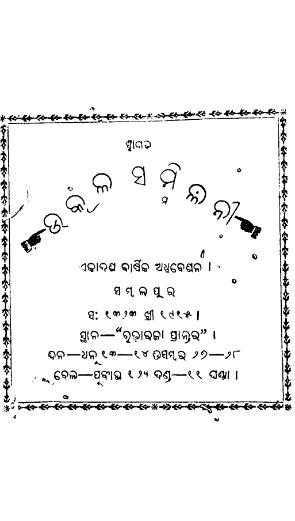In the early 20th century, Odisha was undergoing a significant transformation in its social, cultural, and political landscapes, culminating in the formation of various organizations aimed at fostering regional pride and unity. One of the noteworthy contributions to this movement was the publication of Utkala Sammilani Sambalpur Adhibesana in 1915. This report documents the deliberations and resolutions of the Utkala Sammilani, a key organization in Odisha’s history that focused on the cause of the Odia-speaking regions and the promotion of Odia culture and identity.
The Utkala Sammilani was established in 1903, with the mission of uniting Odia-speaking people and advocating for their rights. The 1915 Sambalpur Adhibesana, or conference, exemplified this vision as it brought together intellectuals, activists, and leaders from various walks of life. The assembled delegates engaged in discussions that addressed critical issues of the time, including education, language preservation, economic development, and political representation.
The report of the 1915 conference, Utkala Sammilani Sambalpur Adhibesana, serves as a vital historical document, illustrating the collective aspirations of Odia society during a period of colonial rule. It highlights the urgent need for self-governance and the importance of cultural and linguistic identity in the face of external pressures. The discourse captured in this report reflects the growing awareness among Odia intellectuals about the need to assert their cultural heritage and political rights.
As the report details the proceedings of the conference, it reveals the passionate pleas of various speakers who articulated the frustrations and dreams of the Odia community. They emphasized the necessity of promoting the Odia language and literature in educational institutions, which was crucial for nurturing a sense of belonging and pride among the younger generations. The discussions underscored that education was not merely an individual pursuit but a collective responsibility to uplift the community as a whole.
Among the many resolutions passed during the Sambalpur Adhibesana, one of the key outcomes was the call for the unification of all Odia-speaking regions, a demand that would later play a pivotal role in the formation of the separate state of Odisha in 1936. This call for unity was not just a political stance but also a cultural reaffirmation, highlighting the shared heritage and values of the Odia people. The conference laid the groundwork for future movements advocating for regional recognition and autonomy.
The report also sheds light on the efforts of the organizers to encourage greater participation from women and marginalized communities, marking a progressive step towards inclusivity in the socio-political discourse of the time. It reflects an emerging recognition of the importance of diverse voices in shaping the future of Odisha.
Today, Utkala Sammilani Sambalpur Adhibesana stands as a testament to the resilience and determination of the Odia people in their quest for identity and self-determination. The discussions and resolutions captured in this report continue to inspire contemporary movements for cultural revival and regional autonomy.
Books Info
| Books name | Utkala Sammilani Sambalpur Adhibesana / ଉତ୍କଳ ସମ୍ମିଳନୀ ସମ୍ବଲପୁର ଅଧିବେଶନ |
| Author | NA |
| No Of pages | 23 |
| Publisher | NA |
| Publication | 1915 |
| Printed At | NA |
| Distributor | NA |

